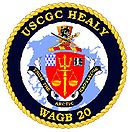USCGC Healy (WAGB-20)
 |
|
| History | |
|---|---|
|
|
|
| Name: | USCGC Healy |
| Namesake: | Michael A. Healy |
| Builder: | Avondale Shipyard |
| Laid down: | 16 September 1996 |
| Launched: | 15 November 1997 |
| Commissioned: | 10 November 1999 |
| Motto: | Promise and Deliver |
| Status: | In service |
| Badge: |
|
| General characteristics | |
| Type: | Icebreaker |
| Displacement: | 16,000 long tons (16,257 t) |
| Length: | 420 ft (128 m) |
| Beam: | 82 ft (25 m) |
| Draft: | 29 ft 3 in (8.92 m) |
| Installed power: |
|
| Propulsion: |
|
| Speed: |
|
| Complement: |
|
| Aircraft carried: |
|
| Notes: | 5 laboratories: Main Lab, Wet Lab, Bio-Chem Lab, Electronics Lab, Meteorological Lab |
USCGC Healy (WAGB-20) is the United States' largest and most technologically advanced icebreaker. She is classified as a medium icebreaker by the U.S. Coast Guard. She is homeported in Seattle, Washington and was commissioned in 1999. On September 5, 2015, USCGC Healy became the first unaccompanied United States surface vessel to reach the North Pole. The current Commanding Officer is Captain Jason Hamilton. Captain Hamilton assumed command of Healy in May, 2015.
Healy was built by Avondale Industries in New Orleans, Louisiana. The construction included a technology transfer agreement between Avondale Industries and the Finnish Kværner Masa-Yards Arctic Technology Centre, where the latter provided expertise for hull form development and propulsion line engineering based on the Finnish diesel-electric icebreaker Otso.
Healy is named in honor of United States Revenue Cutter Service Captain Michael A. Healy. Her keel was laid on 16 September 1996. Healy joined the icebreakers USCGC Polar Star (WAGB-10) and USCGC Polar Sea (WAGB-11) in their homeport of Seattle, Washington on 10 November 1999. The ship departed New Orleans on January 26, 2000, performing sea trials off of San Juan, Puerto Rico, and in Baffin Bay between Canada and Greenland. She arrived in Seattle on 9 August 2000 after transiting the famed Northwest Passage and was placed "In Commission, Active" on August 21, 2000.
...
Wikipedia

